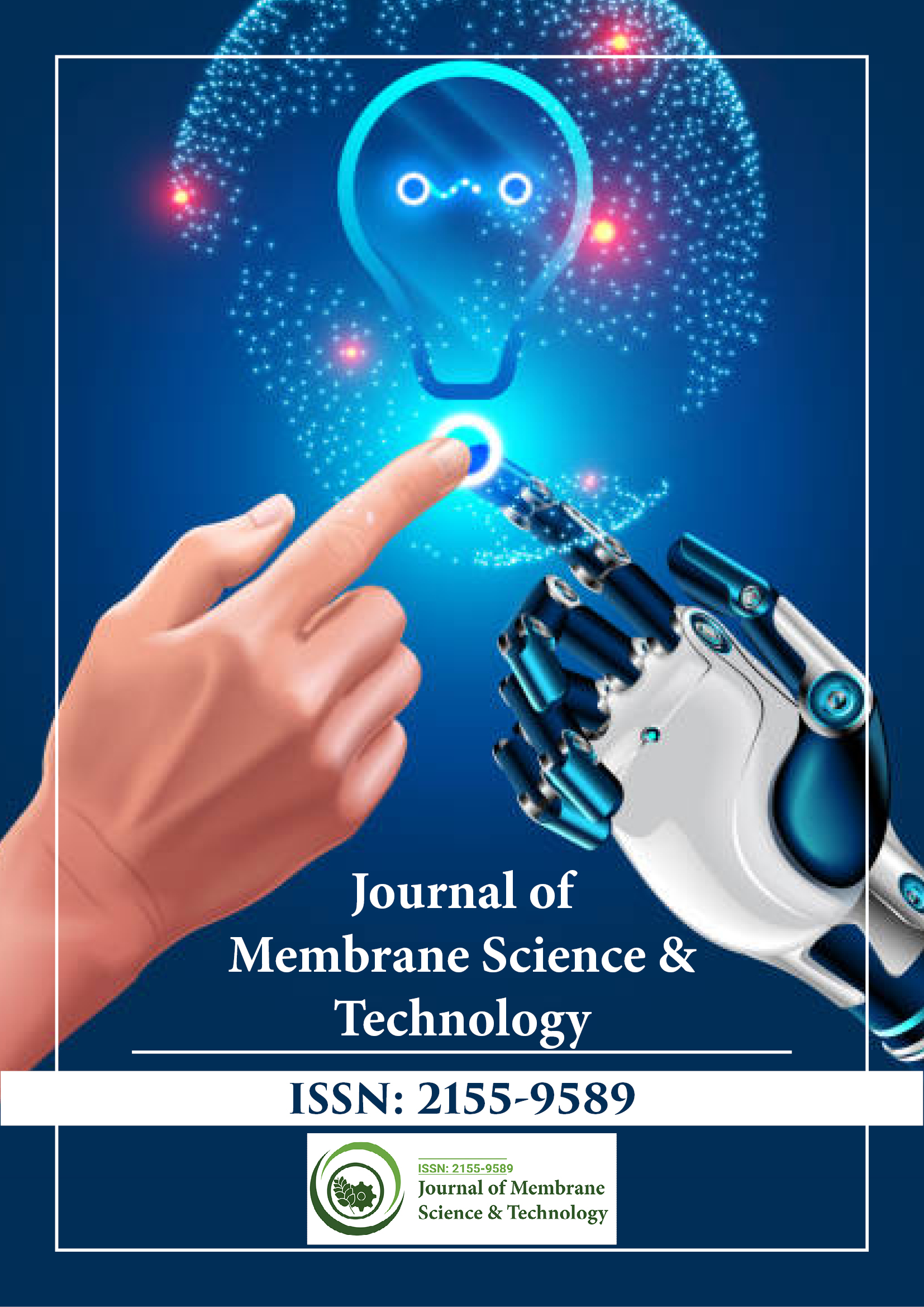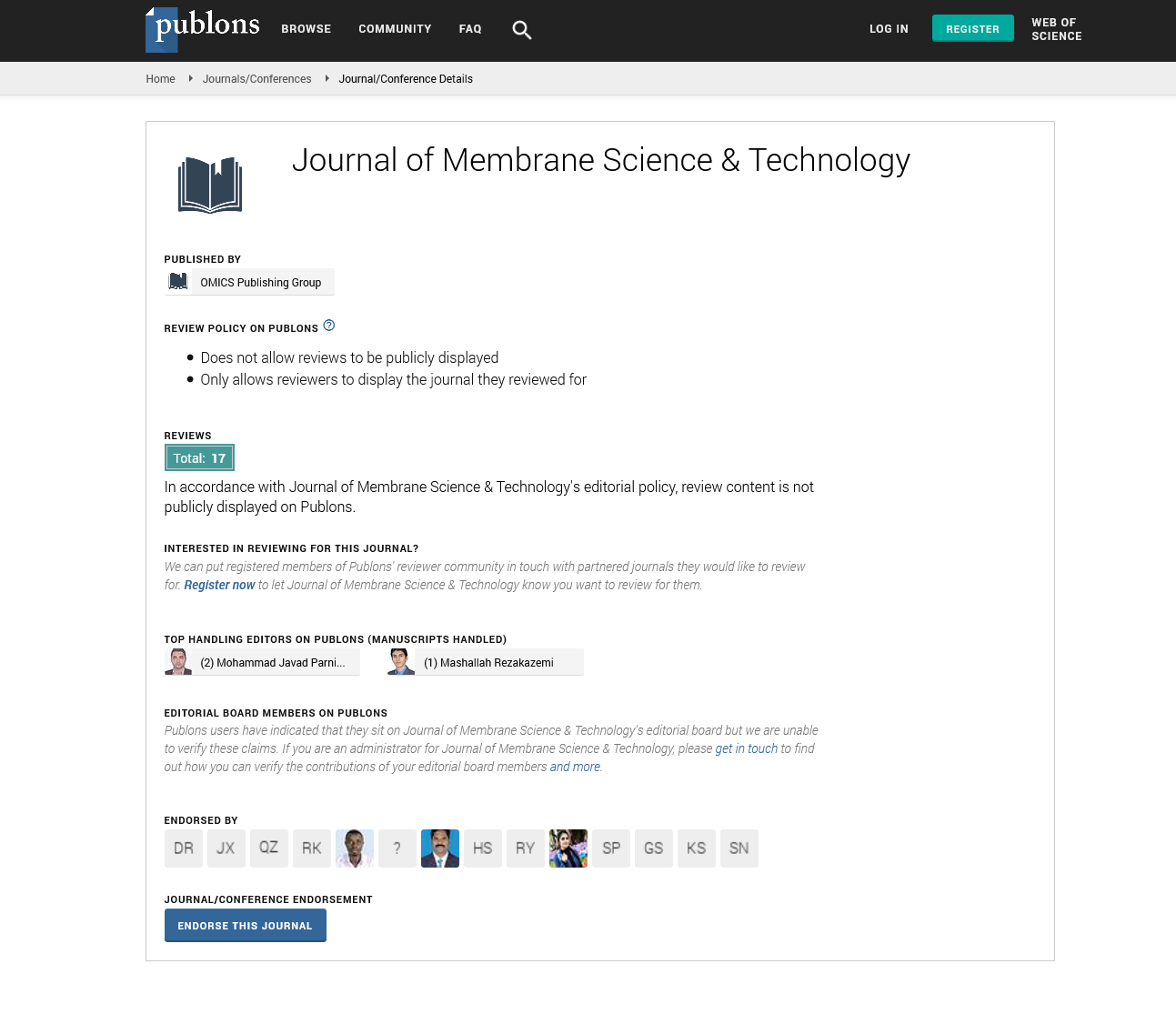Indexed In
- Open J Gate
- Genamics JournalSeek
- Ulrich's Periodicals Directory
- RefSeek
- Directory of Research Journal Indexing (DRJI)
- Hamdard University
- EBSCO A-Z
- OCLC- WorldCat
- Proquest Summons
- Scholarsteer
- Publons
- Geneva Foundation for Medical Education and Research
- Euro Pub
- Google Scholar
Useful Links
Share This Page
Journal Flyer

Open Access Journals
- Agri and Aquaculture
- Biochemistry
- Bioinformatics & Systems Biology
- Business & Management
- Chemistry
- Clinical Sciences
- Engineering
- Food & Nutrition
- General Science
- Genetics & Molecular Biology
- Immunology & Microbiology
- Medical Sciences
- Neuroscience & Psychology
- Nursing & Health Care
- Pharmaceutical Sciences
Opinion Article - (2025) Volume 15, Issue 1
Reverse Osmosis: A Key Technology for Purifying Water in the Modern World
Birgite Ahiring*Received: 31-Jan-2025, Manuscript No. JMST-25-29278; Editor assigned: 03-Feb-2025, Pre QC No. JMST-25-29278 (PQ); Reviewed: 17-Feb-2025, QC No. JMST-25-29278; Revised: 24-Feb-2025, Manuscript No. JMST-25-29278 (R); Published: 03-Mar-2025, DOI: 10.35248/2155-9589.25.15.414
Description
Reverse Osmosis (RO) has emerged as one of the most important technologies in modern water purification, offering a powerful solution to the global challenges of water scarcity and pollution. Initially developed to desalinate seawater, reverse osmosis has since evolved into a key component of water treatment systems across residential, municipal, and industrial sectors. Its core advantage lies in its ability to remove a vast range of contaminants from water, making it safe, clean, and suitable for a variety of applications.
At its foundation, reverse osmosis operates on a scientific principle that is essentially the reverse of natural osmosis. In osmosis, water naturally moves across a semi-permeable membrane from a region of low solute concentration to a region of higher concentration in an effort to balance concentrations on both sides. RO technology disrupts this natural process by applying external pressure to push water from the more concentrated side, such as seawater or polluted sources, through the membrane to the less concentrated side, effectively separating pure water from dissolved impurities. The membrane used in RO systems is finely engineered to allow only water molecules to pass while blocking larger molecules like salts, bacteria, viruses and other contaminants.
A typical reverse osmosis system consists of several interdependent components designed to ensure efficient purification. Water first passes through pre-treatment filters, which remove larger particulates, chlorine, and organic matter that could damage the sensitive RO membrane. The high-pressure pump then forces the pre-treated water through the semi-permeable membrane. On the other side, purified water—often referred to as permeate—is collected in a storage tank, while the waste stream, known as brine or concentrate, containing the rejected contaminants, is directed to a drain. A post-treatment stage may follow, usually involving activated carbon filters or Ultraviolet (UV) disinfection, to improve taste and provide an extra layer of safety.
Reverse osmosis technology has become highly versatile and finds applications across a broad spectrum of needs. One of its most critical uses is in the desalination of seawater and brackish water, especially in water-scarce regions like the Middle East and parts of North Africa. In these areas, RO is a lifeline, turning otherwise unusable water into a reliable drinking source. In urban settings, municipalities use reverse osmosis to meet drinking water quality standards, particularly where natural water supplies are compromised by pollutants or pathogens. The industrial sector depends on RO to produce ultra-pure water for processes that demand high-quality input, such as pharmaceutical production, food and beverage manufacturing and electronics fabrication. On a smaller scale, RO systems are common in homes, where they provide clean drinking water by removing harmful substances such as lead, arsenic, nitrates, and fluoride.
The advantages of reverse osmosis are numerous. Its capacity to remove up to 99% of dissolved salts, microbes and chemical contaminants makes it one of the most effective purification methods available. Beyond safety, RO-treated water often tastes better because the process eliminates chlorine and other substances that cause unpleasant flavors or odors. Compared to thermal desalination techniques, RO is generally more energy-efficient, especially when treating brackish water. Furthermore, modern systems are compact and modular, making them easy to install and scale depending on the user’s needs.
However, reverse osmosis is not without its limitations. One of the most common concerns is the amount of water wasted during the purification process. For every gallon of purified water, a few gallons of brine may be produced and discarded. Energy consumption, particularly in seawater desalination, remains a challenge as high-pressure pumps require substantial power input. The membranes themselves are prone to fouling from scale or biological matter, requiring regular maintenance, cleaning and eventual replacement. These factors contribute to higher operational costs, especially in large-scale deployments.
To overcome these challenges, significant advancements are being made in RO technology. Energy recovery devices are now commonly used in larger systems to reclaim and reuse energy from the brine stream, drastically reducing overall power consumption. New generations of membranes offer higher permeability and better resistance to fouling, extending their lifespan and reducing maintenance demands. Hybrid systems that combine RO with ultraviolet disinfection or Nano filtration are being adopted to improve overall water quality while reducing the load on any one component. Additionally, smart monitoring systems equipped with sensors are becoming increasingly popular, allowing real-time tracking of water quality, membrane performance and system maintenance needs.
From an environmental standpoint, while reverse osmosis provides a sustainable source of clean water, the disposal of brine remains a significant concern. Improper management of this waste stream can lead to environmental degradation, especially in coastal or sensitive ecosystems. Strategies such as evaporation ponds, deep-well injection and zero-liquid discharge systems are being employed to mitigate the impact. In some cases, brine is even being reused in industrial processes to extract valuable minerals or to aid in energy generation.
Conclusion
Ultimately, reverse osmosis stands out as a transformative solution to some of the most pressing water-related challenges of our time. Its ability to produce clean and safe water from sources once considered unusable ensures it remains vital in our efforts to secure global water supplies. With ongoing research and innovation focused on improving efficiency, reducing waste and enhancing sustainability, reverse osmosis will continue to be a cornerstone of water purification technology for generations to come.
Citation: Ahiring B (2025). Reverse Osmosis: A Key Technology for Purifying Water in the Modern World. J Membr Sci Technol. 15:414.
Copyright: © 2025 Ahiring B. This is an open-access article distributed under the terms of the Creative Commons Attribution License, which permits unrestricted use, distribution, and reproduction in any medium, provided the original author and source are credited.

